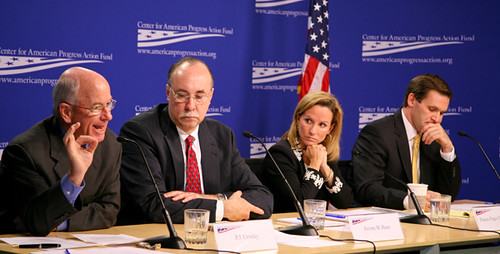Earlier this month, I attended a panel discussion at the Center For American Progress (CAP) in Washington, D.C. titled “Beyond Duct Tape and Color Codes: How the New President Can Engage the Public on Homeland Security”. The event was part of the Homeland Security Presidential Transition Initiative (to which I have offered some ideas on citizen preparedness), a joint project of CAP and the non-partisan think tank, Third Way.Â
The panelists were President Bush’s former White House Homeland Security Adviser Fran Townsend, New York City’s first Office of Emergency Management Director Jerry Hauer and CAP’s Director of Homeland Security P.J. Crowley, an ex-Clinton Administration national security official. The moderator was CAP’s Michael Signer who is heading up the Transition Initiative.
It was as interesting a discussion on the topic of homeland security and the public that I remember attending. Many panels touch on the role of the public in homeland security, say how important the subject is, and then move on quickly to other concerns. But this discussion focused on the citizen angle for the entire 110 minutes. A video of the entire event can be found on the CAP website here.
Despite the bipartisan makeup of the panel, there was general agreement on a number of ways the next Administration should approach homeland security and the public, including:
*better inform and engage citizens on homeland security issues;Â
*begin a dialogue with public — nationally and in local communities — on difficult homeland security issues (Townsend suggested one topic should be ‘the balance between security and civil liberties’);
*discuss with and explain to the citizenry what is the terrorist threat and capability;
*engage the public in a conversation towards developing national priorities and expectations for homeland security as well as its definition. also, continue to knock down policy silos among the different aspects of homeland security;
*take politics, to the extent possible, out of homeland security policymaking, oversight and communications;
*streamline congressional oversight of the Homeland Security Department and limit homeland security porkbarreling — and bring both to public’s attention if change is not forthcoming; and
*ensure that government authorities competently respond to disasters but also strongly emphasize the need for public and communities to be prepared and self-reliant, particularly for the first 72 hours.Â
The bipartisan consensus at this panel would seem to underscore that there will be a new focus in the next Administration — no matter which candidate wins — on informing and engaging the public on homeland security issues.
 
P.J. Crowley makes a point while (l-r) Jerry Hauer, Fran Townsend and moderator Mike Signer look on at a Center For American Progress panel, “Beyond Duct Tape and Color Codes: How the New President Can Engage the Public on Homeland Security”.
Below are some other thoughts on the public and homeland security offered by the panelists during the panel:
Townsend:Â
*Acknowledging that “we [the Bush Administration] haven’t done a great job” on public preparedness, Townsend urged the next Administration begin a dialogue with the American people on a grass roots level in communities, schools, senior citizen homes, etc. before the next major event.
*She said there is “no playbook” for preparing for the public range of the threats of 21st Century. But some of the most effective social education models — ie. seat belts and fire safety — have utilized children to convince “skeptical adults”. Townsend said that children can handle preparedness messages (”We tend to underestimate them…They are not going to be frightened. They actually enjoy the learning process.”)Â
*A goal of the next Administration should be to encourage and “incentivize but not control” and manage public preparedness efforts. For example, she suggested tying state and local grants to citizen preparedness metrics. Â
Hauer:Â
*Hauer said the new Administration must first reestablish credibility with public on homeland security and deal with “fatigue” over emergency messaging.
*The Administration needs to empower the public with information and keep people engaged in their own homeland security.
*He recommended that the Community Emergency Response Team (CERT) program be expanded as a way to increase citizen involvement in disaster preparedness and recovery.
Crowley:
*Seven years after 9/11 and three years after Katrina, Crowley said we need to take stock on what is the nature and capability of the threat. (ie. can AlQaeda threaten our way of life?). And as terrorists rely on their targets to overreact, we need to put terrorism in the right perspectiveÂ
*When it comes to terrorism, Crowley said, we should ask the question whether our objective ‘this will never happen again’ or should our expectations be more along the lines of Britain or Israel where they expect that periodically the bad guys will succeed but over time strategically the good guys will prevail.Â
*And, “the public has to be part of this conversation.”




2 responses so far ↓
1 Irene Long // Oct 14, 2008 at 12:51 am
The FEMA and Red Cross Food and Water in an Emergency Guideline (and companion video) have called for at least TWO WEEKS emergency supply for years now. Please stop using the decades old pre-Katrina 72 hours preparedness guideline. When the southern San Andreas Fault, for example, finally ruptures in what is likely to be our next major natural disaster, there is no way there will be adequate water resources available for 22 million people within 72 hours.
2 Cargo Screening, The Economy, Leukemia, And Why We Need A Public Discussion On Risk Among Government & Citizens // Apr 9, 2009 at 8:39 am
[...] only from policymakers but with the guidance of the public itself. Crowley made that point in a Washington, D.C. pre-election panel I attended: When it comes to terrorism, he said, we should be asking whether our objective is ‘this will [...]
Leave a Comment